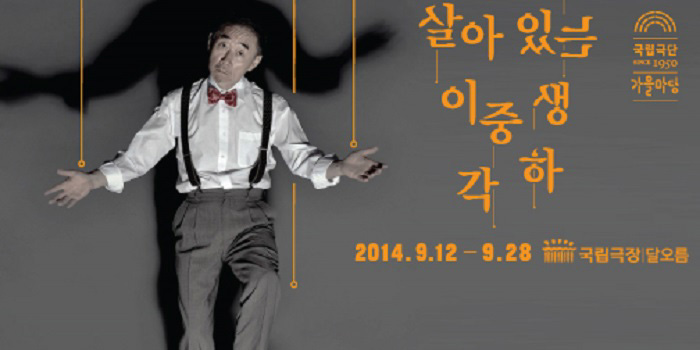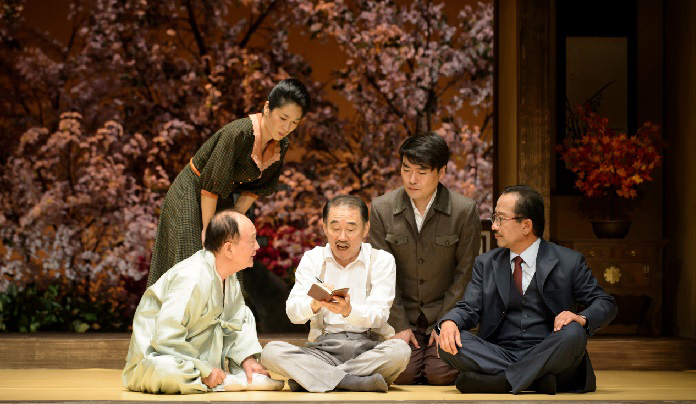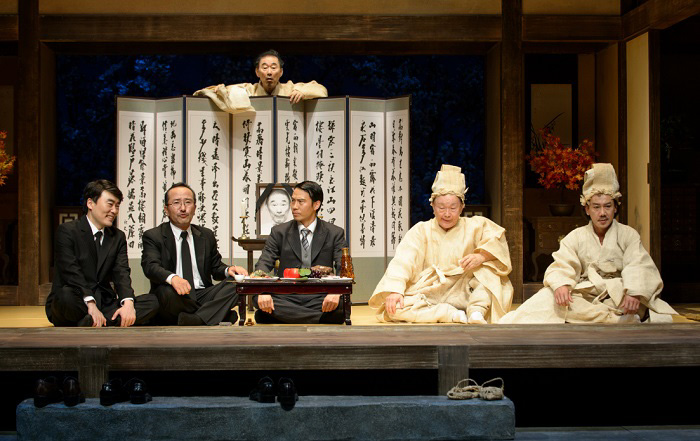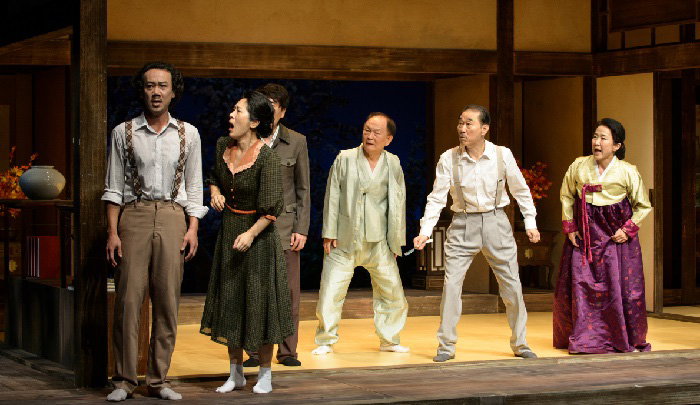If you had the chance to see a certain play staged at the National Theater of Korea on September 12, it felt like being back on the streets of Seoul in the 1930s and 1940s.
The story of “Lord Lee Joongsaeng, Alive,” a novel penned by Oh Young-jin (1916-1674), was relived on stage from September 12 until 28, brought to life through the outstanding production skills of director Kim Gwang-bo. Oh Young-jin, who is best-known for his play “Maeng Jinsa’s Happy Day,” wrote the novel in 1949.


The stage version of "Lord Lee Joongsaeng, Alive," is set during the Japanese colonial era. The story begins as the main character, Lee Joong-saeng, a pro-Japanese father, prepares for a garden party to celebrate his successful business.
Lee is the kind of man who would do anything to make money, going so far as to encouraging his own son to volunteer for the Imperial Army. As all the corruption and irregularities behind his wealth are disclosed to the public, Lee pretends to commit suicide in an effort to keep his wealth. The deception, however, soon meets an unexpected snag, as the fake will he forges ends up bringing all his wealth to the brink of being given to charity. Now, Lee tries to find a way to become legally alive once again. Unfortunately, he ends up taking his own life immediately adjacent to the coffin he prepared for his fake suicide.
Behind Lee’s tragic life lies the writer’s intention to reveal human nature and the absurdity of materialism and snobbishness, all prevalent in this world.
Producer Kim Gwang-bo is credited for turning the story into a black comedy, full of satire and humor, exactly the way the story is found in the original.
For example, the stage producer used such words as biru, which means “beer” in English, exactly as they were used in the original novel. Also, the play is set featuring street scenes and an atmosphere from the 1930s and 1940s, as in the novel.
The cast sported hilarious and realistic facial expressions, engaging the audience in the show, too. The audience was enraptured when family members shed crocodile tears during the fake funeral for Lee, or when Lee gets upset after he overhears his son-in-law arguing that all his wealth should be donated to charity.


The audience was captivated to the end, taking pleasure in seeing the greedy Lee, first, ask for trouble and then get what he deserved. At the same time, it might feel pity for him, because the audience realizes at some point that there are still people like Lee out there in the world, people who are blinded by snobbism and greed.
Lee’s story gave the audience some pause to look back on themselves, watching Lee, whose only goal is to become rich and to achieve fame by means of money, and his tragic end, which gives a meaningful lesson.
Meanwhile, the audience grows aware that there’s still hope out there in the world, though, as they saw in Lee’s son and son-in-law who argue that giving back the deceased Lee’s wealth to society is the right thing to do.

“We can say this work is a success only when the audience realizes that there exist so many Lee Joong-saengs out there in the world in which we are living,” said stage actor Chung Jin-gak, who plays the main character Lee Joong-saeng in this production. “The more you link the messages delivered in the play to what’s happening in society in which you are now living, the more lessons you can get.”
By Lee Jeong-rok, Sohn JiAe
Korea.net Staff Writers
Photos: the National Theater of Korea
jeongrok@korea.kr
The story of “Lord Lee Joongsaeng, Alive,” a novel penned by Oh Young-jin (1916-1674), was relived on stage from September 12 until 28, brought to life through the outstanding production skills of director Kim Gwang-bo. Oh Young-jin, who is best-known for his play “Maeng Jinsa’s Happy Day,” wrote the novel in 1949.


A scene from the play “Lord Lee Joongsaeng, Alive,” in which the Lee Joong-saeng family helps Lee to fake his own death, creating a fake will, to help him get away with tax evasion and breach of duty.
The stage version of "Lord Lee Joongsaeng, Alive," is set during the Japanese colonial era. The story begins as the main character, Lee Joong-saeng, a pro-Japanese father, prepares for a garden party to celebrate his successful business.
Lee is the kind of man who would do anything to make money, going so far as to encouraging his own son to volunteer for the Imperial Army. As all the corruption and irregularities behind his wealth are disclosed to the public, Lee pretends to commit suicide in an effort to keep his wealth. The deception, however, soon meets an unexpected snag, as the fake will he forges ends up bringing all his wealth to the brink of being given to charity. Now, Lee tries to find a way to become legally alive once again. Unfortunately, he ends up taking his own life immediately adjacent to the coffin he prepared for his fake suicide.
Behind Lee’s tragic life lies the writer’s intention to reveal human nature and the absurdity of materialism and snobbishness, all prevalent in this world.
Producer Kim Gwang-bo is credited for turning the story into a black comedy, full of satire and humor, exactly the way the story is found in the original.
For example, the stage producer used such words as biru, which means “beer” in English, exactly as they were used in the original novel. Also, the play is set featuring street scenes and an atmosphere from the 1930s and 1940s, as in the novel.
The cast sported hilarious and realistic facial expressions, engaging the audience in the show, too. The audience was enraptured when family members shed crocodile tears during the fake funeral for Lee, or when Lee gets upset after he overhears his son-in-law arguing that all his wealth should be donated to charity.


Scenes from the play “Lord Lee Joongsaeng, Alive.” Lee Joong-saeng fakes his own death and his family holds a fake funeral.
The audience was captivated to the end, taking pleasure in seeing the greedy Lee, first, ask for trouble and then get what he deserved. At the same time, it might feel pity for him, because the audience realizes at some point that there are still people like Lee out there in the world, people who are blinded by snobbism and greed.
Lee’s story gave the audience some pause to look back on themselves, watching Lee, whose only goal is to become rich and to achieve fame by means of money, and his tragic end, which gives a meaningful lesson.
Meanwhile, the audience grows aware that there’s still hope out there in the world, though, as they saw in Lee’s son and son-in-law who argue that giving back the deceased Lee’s wealth to society is the right thing to do.

A scene from the play “Lord Lee Joongsaeng, Alive” shows Lee Joong-saeng's family in discord as he tries to divvy up his wealth.
“We can say this work is a success only when the audience realizes that there exist so many Lee Joong-saengs out there in the world in which we are living,” said stage actor Chung Jin-gak, who plays the main character Lee Joong-saeng in this production. “The more you link the messages delivered in the play to what’s happening in society in which you are now living, the more lessons you can get.”
By Lee Jeong-rok, Sohn JiAe
Korea.net Staff Writers
Photos: the National Theater of Korea
jeongrok@korea.kr
Most popular
- Military discharge sets stage for reunion of all 7 BTS members
- 'We are back!' BTS Festa heralds hyped return of K-pop phenom
- Presidents Lee, Trump discuss tariff deal in first phone talks
- President Lee leaves for G7 Summit in Canada on first int'l trip
- 'Maybe Happy Ending' wins 6 Tonys including Best Musical
